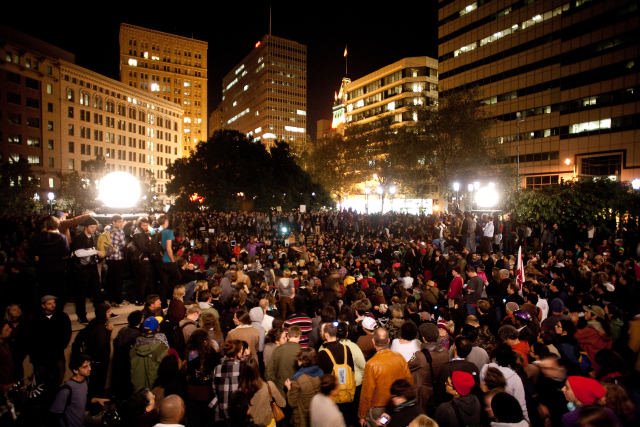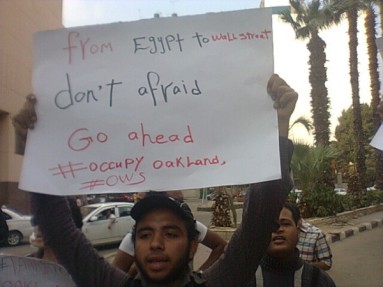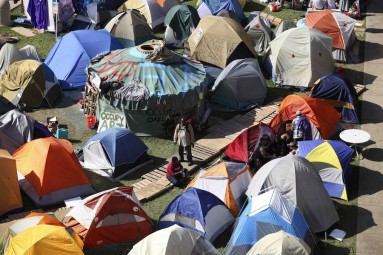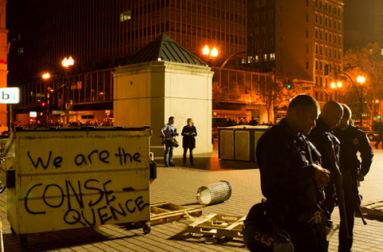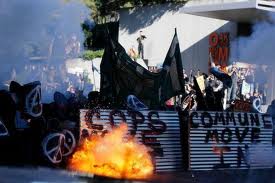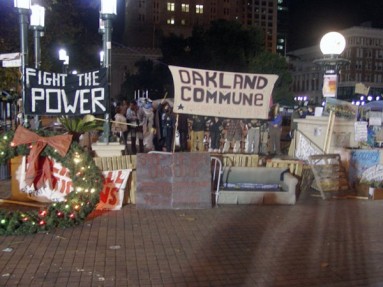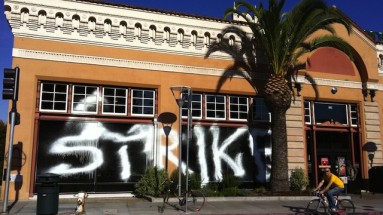When
First off, the question of timing. Why now? Or rather, to put it in more pointed terms, since the economic crisis has ushered in a newly volatile and riotous age, why did it take so long? Why did Occupy erupt in 2011 and not 2009 or 2010? Did people reach some kind of breaking point, as the economic crisis worsened month by month, as unemployment came to seem a permanent rather than transitional stage, as debts became more and more unpayable, mortgages more and more burdensome? Notably, 2011 was the year in which the effects of the crisis were particularly devastating for governmental budgets, precipitating numerous opportunistic austerity programs, particularly at the state and municipal levels. But why, then, didn’t Occupy emerge as an anti-austerity movement, as observers of events in Europe since 2008 might have predicted? Why did attempts to reproduce the Madison Capitol occupation of the preceding spring fail so miserably? Is it because of the weakness of the traditional actors in such movements, such as public sector unions? Or the deep-seated anti-statism of Americans? It is certainly notable that, unlike Greece or the UK– where the capital is also the largest city, capable of generating the largest protests – most major cuts in the US are undertaken by state rather than federal governments, meaning there is unlikely to be a single piece of austerity legislation that will conjure forth a nationwide protest movement.
As we know, Occupy imagines itself as a link in a global chain of protests which begins in Tunisia, spreads to Egypt and from there to the cities of Spain, to Greece and beyond. By the time it gets to Europe and the US, this new International of protest quite self-consciously casts itself as propagated spontaneously through ineluctable processes of contagious, “viral” replication and imitation, sometimes attributed to the dispersive, participatory character of social media. In my view, “spontaneous” is simply the name we apply to those social manifestations whose causality we don’t really understand, and if one looks closely at any of these instances, one sees groups reading the direction of the historical winds and making choices based on their sense of what’s possible. In other words, there are always specific acts of will within, if not behind, any spontaneous emergence – as we learn from the text messages the rioters of Britain sent each other – and this is certainly the case with Occupy Wall Street’s original manifestation. What distinguishes it from the earlier sequence is how long it took, how much delay there is between Syntagma Square and Zuccotti Park. This is one question we need to answer: why did it take so long? And what is it that this delay measures? One answer might be that it measures the uncertainty, here in the US, about the target, the object, around which a protest movement might cohere. As we will see, this uncertainty turns out to be crucial to the course Occupy takes.
Where
Occupy emerges, then, from this new, subterranean International of contagious and semi-spontaneous protest, of images and affects that circulate from place to place. The economic crisis is the conducting medium through which these transmissions pass. Without it, without the internationalization of austerity and immiseration, such contagion could never occur. The globalized and globalizing miseries of the economic crisis are what allow for this process of transnational identification – equating Wisconsin Governor Scott Walker with Hosni Mubarak, for instance – to be other than completely farcical. The vast numbers of Egyptian and Tunisian college graduates, no longer assured a place in the state bureaucracies and the middle-classes, really do resemble in some structural manner the numbers of American degree-holders who likewise graduate with no employment prospects and cartloads of debt. There is an actual rather than merely representational leveling of experience at work here – and this is why the media determinists who ascribe causal power to Twitter or other social media get it wrong. The importance of the widespread use of Twitter and Facebook in places like Egypt and Tunisia is that it is one face of a more intensively and extensively integrated global economy. The increasing similarity of commodities and technologies and even cultural forms worldwide – a similarity which, as we know, is actually a mechanism for economic inequalization – makes it easier for these protests and rebellions to spread. In other words, the representational leveling of the world effected by the various media piggybacks on the real leveling that is capitalist globalization. Underneath the representational circuits are economic circuits – slow flows of raw materials and commodities, fast flows of credit and currency – and it is through the these globalized circuits that the economic crisis which began, in some sense, with the US housing market and the related asset bubble, fanned out into the world, wreaking havoc and creating the conditions of possibility for this political sequence.
There is something very curious, however, about the protests which do emerge from these international circuits. Even though Occupy and its antecedents in the “movement of squares” emerge from this space of circulation, as tactics they are supremely anti-circulational. They are tactics of staying put, of claiming space. This is one of the things we will want to answer about Occupy. Why is it that a so-called leaderless and decentralized movement – based upon the contagious proliferation of slogans, tactics, images and practices – should require physical centralization in the central squares of our cities? Why the camp?
Perhaps it makes a certain intuitive sense that the relentless circles of global capitalism would find their opposite shape in the classical geometry of the squares, that the ceaseless movement of the economy would precipitate a politics of refusing to move, of stopping, staying-put and, as we will see, blockading. One point that has not been made enough is that the camps respond to the evisceration of our cities, the enclosure, hyper-regulation and homogenization of the life of the street, which has left precious little public space where people can encounter each other which is not mediated by commodities and by money. American cities feature little free space, in the dual sense of the word, meaning both unregulated and without cost. If part of capitalism’s development is to ensure that it remains the only human community possible – to ensure, in other words, that all interactions between people are mediated by money and commodities, by the police and various state bureaucracies, or by technologies whose raison d’être lies in the market and the workplace – then part of the appeal of the camps is that they promise (and I think it is just a promise) a form of community that is not automatically produced by economic transactions and predefined social categories. I think we should pause for a second and consider how remarkable it is for a generation of young people whose social life has been so entirely captured by social media – by screens, in other words – to attempt to encounter each other face-to-face as they did, how remarkable it is that the first post-internet generation of young people should produce a politics that is all about dwelling together in common. Occupy focuses on the creation of community – or communities – because so many of the existing communities on which past political movements relied have been dissolved, broken-up and reconstructed by capitalism in its own image.
Therefore, although the camps were originally conceived as the means to a political end, they quickly become the most compelling feature of the entire movement. People forget about the trajectory which the original call for Occupy Wall Street sketched out, in which the occupiers would encamp and, through a deliberative process, discover their “one demand” (equivalent, one supposes, to a call for Mubarak’s departure or a down-vote on an austerity law). But there is no single demand which can unite the motley crowds in the squares. Solidarity has to be produced, rather, through other mechanisms, through the camps and not just the assemblies, through the process of living together and not just the deliberations of the assemblies.
Some will know that Occupy draws its inspiration, in part, from the wave of California university occupations in 2009-10, when significant debates about demands and demandlessness occurred. Many of the key texts from this movement, such as the Communique from an Absent Future, argued for the impossibility of all demands (and the impossibility of significant reform) given the currently moribund state of capitalism. But this argument was an ideological position, something which had to be put in the form of polemic. In the case of Occupy, this position – once the voice of the ultraleft – is simply the status quo. The debate had been silently won. Let’s be clear: I am not arguing that Occupy is a revolutionary movement, aimed at the total destruction of capitalism, the wage relation and the State. This is obviously untrue: for the most part, Occupy has a reform-oriented horizon that is clear to all. It is about class inequality in the US, about the distribution of wealth between the 99% and the 1%. Its implicit demand is: Fix this. Make our society more equal. But this demand remains almost impossible to voice, since there is no concrete policy to recommend and, arguably, little outside a revolutionary movement is likely to significantly impact inequality in the US anytime soon. As such, any attempt to reduce this unspoken horizon to some concrete object, whether the Citizens United ruling or full employment, remains curiously both too specific and too vague, likely to fragment the 99% into competing factions.
The camps are, therefore, a residue of the impossibility of demanding. It is not the demand which unites the camps but the processes of mutual aid and care which they require. The very fact of trying to live together outside of the usual forms which make life possible – money, compelled labor, the police – produces solidarity, and the deliberative process of establishing consensus in the assemblies is only one part of this. Some will discuss such an emphasis on social reproduction and mutual aid by way of the contemporary anarchist language of prefigurative politics. For thinkers like David Graeber and Cindy Milstein, whose ideas were directly or indirectly important to the initial Occupy Wall Street mobilization, the camp prefigures the future (non-capitalist) society it strives toward. Its means are therefore equal to its ends. The camp becomes its own demand, as was often said. Certainly, there is much to critique in this view. I do not think that the Occupy camps really resemble – in any literal, structural or even symbolic way – the kinds of social arrangements we might see during or after a revolutionary transformation of society. They are not really an image of the future I want. But the camps do anticipate, in some regard, the kinds of questions, problems, and logistical challenges such a transformation might require. In other words, they allow people to experiment with solutions to problems for which capitalism has, for the most part, readymade answers (destructive ones) or no answers at all. They therefore perform a certain negative prefiguration. The real value of these experiments lay not in developing tactics and methods which could be used in a future revolutionary situation but in making clear what the problems and challenges are. The camps, in this sense, manifest how little we know, how little we can do, how tremendously unprepared we would be for the opportunity to reconstruct social life. If there is a moment of positive prefiguration, it lies in the fact that the camps attest to the incredible practical ingenuity and enthusiasm which people bring to such situations. Where Occupy succeeds, it does so because it actively encourages people to involve themselves in existing activities, to organize new projects, and to come up with solutions to the problems they encounter.
Still, Occupy presented people with problems for which they were entirely unprepared. As numerous people will attest, the Occupy camps often felt wildly unsafe, shot through with sexual violence, trans- and homophobia, and open racism. We know that some people experience such liberated spaces as licensing the most repellant of impulses. Though various initiatives responded to these kinds of problems, I doubt there is a single large encampment which counts its response to these issues as successful. Beyond or alongside these problems, one often encountered in the camps various forms of mental illness, trauma and addiction, as well as the conflict and suffering they bring in train. Part of Occupy’s success, in my view, results from the fact that it solicited and encouraged the active involvement of people from whom the economic crisis has exacted the highest toll: newly-homeless and long-term homeless persons. But people whose basic experience of society is one of active exclusion are not easily included in a social movement composed of so many other comparatively privileged class strata. The Occupy camps, to put it bluntly, featured forms of suffering and antisocial violence – from all quarters and classes, it should be clear – for which no one had any good answers.
To give you just one example of what I am talking about, I will tell you the story of S., who lived in Frank Ogawa Plaza (the park in front of City Hall) prior to Occupy Oakland’s tenancy there. As soon as the camp arrived, S. began diligently working in the kitchen, effectively helping to set it up and distribute the cartloads of food which began flowing in. But for reasons that are unclear, S. became increasingly irascible and one day he snapped, brandishing a kitchen knife at someone in response to a dispute. S. then began threatening people and getting into fights several times a day. There were not many options for dealing with the problem: one of Occupy Oakland’s first and most important decisions was that it would maintain absolute autonomy from the police, who were shouted out of the camp whenever they tried to enter. But attempts to mediate the conflict essentially failed, and S. seemed immune to all reason. One day, after he had started another fight, a group formed and attempted to run him out of the camp. But S. came back, more enraged and more dangerous. Finally, in the ensuing scuffle, someone hit him over the head with a 2x4 and knocked him out. When he regained consciousness, he wandered out of the camp, followed by some street medics, who called an ambulance. Two weeks later, though, he returned. His affect was completely changed and he said he was taking some kind of medication. Once again, he became a dedicated participant in camp life, making new friends and involving himself in various projects. But one day, after a police attack on the plaza, he was arrested for obstruction of an officer, a relatively minor misdemeanor. The Antirepression Committee was unable to secure his release, however, because he was on probation. He was transferred to the county jail where, as usual, they refused to give him his medicine. What happened next is unclear, but he is alleged to have assaulted a guard. The charge he received, felony assault on an officer, would have meant a potential “third strike” under California’s three strikes law and, consequently, a life sentence. Although there was an entire subcommittee devoted to his defense, he was forced to take a plea deal in order to avoid the third strike. He is now serving a 4 year prison sentence.
This should give us some sense of the terrain. On the one side, the brutal but probably unavoidable 2x4 to the head; on the other side, the even greater brutality of the state. No one would dare speak about this incident in the language of prefiguration, I hope. If one creates a social movement from people broken by capitalism in all kinds of ways, and situates it in the middle of a city like Oakland, one should be prepared for interpersonal violence of the ugliest sort. What we have, then, in this story, is not a model for the future, but a sketching out of limits: people trying to respond to a difficult situation with the very limited resources available to them. At the same time, the story confirms the essential correctness of Occupy Oakland’s refusal to work with the police, who mean nothing less than a death sentence for S.
Who
In the argument I have been making, Occupy is not only or not just a protest movement. Rather it is about the dispossessed and disenfranchised developing new ways of meeting their needs, of taking care of each other in a situation in which no one else will, in which there are no longer the jobs, nor the governmental provisions, nor even the monetary credit, on which many of them might have relied in the past. This is to place the camp at the center of the narrative. But there is another position on Occupy, which describes the camp as a mere foundation for the creation of directly democratic agora – or spaces of encounter and public appearance – through the general assemblies. In this view, Occupy is really about political discourse, decision, and the formation of a new hegemonic majority, the 99%, through consensus procedure. Its work involves incorporating the views and perspectives of the 99% in order to disclose the hypermajority that is already here and already committed, one supposes, to a certain project of social transformation.
The defining phrase of the Occupy movement, “we are the 99%,” is cleverly constructed so as to sit between a concept of class – the poor against the rich, the 99% against the 1% – and a concept of “the people.” The 99% means almost everyone, next to whom the rich are a mere parasitic superfluity. The movement, in this sense, spreads through a logic of radical inclusivity. Effectively, however, “we are the 99%” emerges – and this is mostly confirmed by a reading of the now-famous tumblr blog from which the slogan derives – as the expression of a fairly distinct class formation. We might think of this class as the “proletarianized middle-class,” where proletarian names the fact of being “without reserves,” without access to any property which one might use to survive. It names a condition of dispossession rather than exploitation: people who have lost their homes or are in the process of losing them, college graduates saddled with student loan debt they can never hope to repay, people who can’t find the decent-paying work they expect . The 99% is a class based on frustrated expectations – a class that feels itself dispossessed of certain rights and comforts. Because this class sits between some stratum of the already-dispossessed and the world of relative privilege from which it has been excluded, it has a ready-to-hand claim to universality. Remember that the middle class is defined by an essential narcissism: the middle-class is always what I am, as opposed to the two groups of people, the poor and the rich, who are not me. This is why someone who is trying to raise children on a $30,000 per year income is just as likely to identify as middle-class as someone who makes five times as much. The 99% is therefore the expression of a certain group of people whose position within capitalism allows them to universalize their experience. It is the expression of a certain group of somebodys who think they are everybody. Needless to say, this process of self-universalization is much easier if you are white.
The great virtue of Occupy, and the source of its power, lies in the fact that the camps force an encounter between this proletarianized middle-class, the 99%, and the ever-growing number of homeless, whose twin destitutions might come to seem like the different faces of a shared proletarian condition. I do not want to make it seem as if these two tendencies, these two perspectives, are mutually exclusive. The 99% might incline by disposition toward the deliberative universalism of the assembly, and the proletariat toward the mutual aid of the camp, but in most instances camp and assembly depended on each other. Still, the question remains: does the camp exist as foundation for the assembly, or the assembly as foundation for the camp? Is Occupy a movement of dispossessed and disenfranchised people taking care of each other and finding ways to survive in conditions of social breakdown? Or is it an attempt to alter the national discourse and opinion, to constitute a new political majority?
What
In a certain sense, it should not surprise us that Occupy is so oriented toward the plane of public opinion and public perception. As I noted above, Occupy emerges out of the flow of images of revolt (and languages of revolt) which cross our screens. These images, traveling through the conducting medium of shared misery, carry with them certain affective charges: horror, wonder, exhilaration. They work as reflectors of a sort, compelling imitation. At a basic level, they say: Yes, this is possible. You, too, can do this. You, too, should do this. The consequence, however, is that some large faction within Occupy comes to believe that its destiny lies within this flow of images. For such people, the point of Occupy is to become visible, to appear, to communicate to other potentially likeminded people, to change opinion through the becoming-visible of the 99%. It is in this sense that the occupations are “manifestations” or “demonstrations,” following a logic of exhibition and publicity. They are giant protest banners which read We are the 99%.
It is because of this logic of exhibition that an entire ideology develops around Twitter messages and livestreamed video, not only endowing these technologies with a supernatural capacity to mobilize and arouse, but more importantly imagining them as politics in and of themselves. The occupation becomes not an occupation through Twitter but of Twitter, not Occupy Wall Street but #ows. The contagious spread of occupations, manifestations, strikes and riots across the globe and across the US is made baldly equivalent with the “viral” proliferation of the internet meme or the twitter hoax.
As hinted at above, one of the reasons why the Occupy camps are so easily referred to the churn of words and images in media both old and new is that their object, their enemy or target, is so supremely abstract. There is no single tyrant to cast out – as in Egypt – much less a “regime.” There is no single piece of legislation to deflect, as with the UK student movement or Greek anti-austerity protests. Even if, as seems fairly accurate at least as far as Occupy’s initial manifestations go, one defines the target narrowly as the finance sector, and the grievance as inequality, these are particularly ethereal objectives and targets. The finance sector is abstract by definition. The operations of a bank, which concern money rather than things for the most part, are not really in any particular place, but rather pass through these places, as distributed flows of information, paperwork, people. Shutting down a bank or even a stock exchange is symbolic in a way that shutting down a factory is not. One can try and find the office where crucial operational functions are located, but even this office is likely to be one among many such offices, distributed throughout cities, throughout the country, and the world. The banks therefore exist in the same abstract interspace to which Occupy is often referred.
How
There are a couple of important consequences of these dynamics that I want to touch on before concluding. One is that an orientation toward political speech and political image – toward the formation of the 99% as image– instantiates a logic of victimization that has been absolutely essential to the growth of Occupy, but at a certain point became a rather severe limit. Occupy’s most explosive growth – in places like New York and Oakland alike – came in response to police repression. Whether we think of the initial pepper-spraying of women at an OWS march early on that so shocked people and swelled its ranks at a crucial early moment (when it seemed uncertain whether the occupation had any momentum), or the near-murder of Scott Olsen by Oakland Police after their raid on Occupy Oakland’s camp, police repression has been the motor of Occupy’s growth, provoking outrage and bringing massive numbers into the street. But at the same time, such responses usually depend on a notion of infringed rights, and implicitly a distinction between good (peaceful) and bad (violent) protesters. Therefore, cynically or not, they end up as mechanisms of self-policing, since people believe that the movement’s growth is predicated on the images of victimization and that they need to play for the cameras accordingly. The goal of getting favorable press – via an entirely hostile news industry – thus becomes an apparatus of self-regulation. There is always something profoundly tautological about these arguments. When asked why they oppose a certain tactic – say, smashing a bank’s window – most people will tell you that they don’t actually care about the window, or the bank, and they don’t think it’s morally wrong, but that they oppose it because other people oppose it and that as a result therefore it causes the movement to lose support. The problem, however, is that one can find very few people who actually oppose such actions for their own sake. Everyone remains spellbound by a collectively hallucinated “public opinion,” in the light of whose stern gaze they are willing to self-police. This other-directedness is one of the problems with the ideology of struggle on the plane of images, and it’s also therefore one of the consequences of the 99%’s class standpoint.
As we’ve seen, both the camp and the assembly emerge, gain tactical supremacy, and become ends in and of themselves because of the essential abstractness of the enemy and the difficulty of demanding anything concrete from such an enemy. Confronted with the impasse of the present, the camps instead orient themselves toward the project of mutual aid and care, and the assemblies toward the integration of new members and viewpoints, precisely because it is unclear where the enemy is exactly, or how one would go about attacking this enemy or impacting its ability to make us miserable. This problem is never really resolved by either solution. Though some may see in the assemblies the seed-form for a reorganization of society along directly democratic lines, and others might see in the camp a reorganization of social life according to principles of free giving and voluntary activity, the vast wealth of capitalist society still remains over there, held under the ownership and political control of the so-called 1%, and quite clearly inaccessible by the dispossessed who camp in the public squares and parks, rather than in the warm, well-lit buildings of the elites. The space of the public which the camps create is therefore also the space of the outside. This is a project that takes place, quite literally, out in the cold.
The danger for the camps, therefore, is that the self-organization of the dispossessed becomes, instead, the self-organization of dispossession, the reproduction of dispossession, rather than a step on the way to its overcoming. The protest camp is unsettlingly close to other kinds of camps: refugee camps, for instance, or the depoliticized encampments of homeless persons that have sprung up across the country in the last few years: fenced-in, patrolled by private security guards, visited from time to time by charities and public workers. In some cities, this is essentially what the Occupy camps became. Unwilling or unable to confront the challenges the camps raised, the middle-class activists of the 99% percent essentially stopped attending, leaving the largely homeless campers to fend for themselves until the inevitable police raid.
I hope that it’s become clear that I don’t find either of the two paths described so far – the path of the camp or the path of the assembly – satisfactory. The assemblies risk a formalism and proceduralism that is ephemeral, detached from people’s real needs, blind to the fact of their very limited power and their tendency to drift toward subtle and not-so-subtle forms of tyranny. On the other hand, the camp, as an end in itself, depends upon the fantasy of creating communism in a small park, ignoring the larger social context on which it depends. Even leaving aside for a moment the fact that the camps relied on money, on commodities produced in the surrounding capitalist world, and, by extension, on the employment of some occupiers – meaning that they were dependent upon the economy which they opposed – it is clear that the camps featured contradictions which were insoluble. There was no way for the camps to persevere and fix the problems they encountered, at least not without a radical transformation and expansion of the ground on which they were constructed. Therefore, even if I side strategically with the party which views the camps and the possibilities for proletarian self-organization they allowed as Occupy’s most significant achievement, there can be little doubt about the stark limits such acts of self-organization encountered.
***
There is, however, an alternate strategic avenue here, one where the Occupy camps and assemblies focus on offensive strategy in addition to self-reproduction or the cultivation of a particular ideological hegemony. But, as noted above, the entities which Occupy opposes are overwhelmingly abstract. Against such vaporous enemies, most tactics will seem too specific, too targeted, specific, and narrow. Furthermore, the class composition of the movement makes certain workplace-based offensive strategies difficult to pursue. How then does a movement composed largely of the jobless and homeless, the underemployed and contingently employed, as well as people who work in difficult to organize service sector jobs, render these very abstract enemies tangible? In other words, where and how do people strike out when action at the site of production as workers (rather than, say, as vandals or protestors ) is largely impossible for them? As we’ve seen, one answer is that they don’t strike out at all and, instead of focusing on elusive enemies, turn inward, building their own capacities. Or they turn outward in a lateral appeal to potential sympathizers. And yet, this is not really a sustainable solution at all, since outward-directed antagonism (whether it’s antagonism toward the banks, the police, or the 99%) vouchsafes the fragile unity of the camps and the assemblies. The autonomy of the camps is only really possible when asserted against something, against some common enemy, some resistant force. In the absence of open confrontation, the various factions and groups within Occupy turn on each other. The camps and assemblies can’t just be defined in simple opposition to the status quo. They have to imagine themselves as expanding, growing, becoming more powerful in measurable ways, lest people lose interest and drift away. This is the sense in which it makes sense to speak of Occupy as a movement. A movement is a social force whose powers in the present derive from the sense, among participants, that things are heading somewhere, that they are part of an unfolding political logic with a direction and an immediate (if not distant) future. Without such a sense of direction, many people won’t get involved.
For the reasons discussed above – the abstractness of the enemies, the class composition of the participants – Occupy’s offensive struggles tend toward certain characteristics. For one, inasmuch as Occupy takes place outside, it also has to attack from the outside. If it aims to interrupt capitalist production, it does so by and large from the side of capitalist circulation, from outside the workplace, by blockading the workplace’s doors or interrupting the circulation of bodies and goods in the surrounding streets. Secondly, the struggles tend toward a certain generality. That is, if they are interventions in the sphere of circulation, they tend to fight not against particular forms of circulation, but against circulation in general. This is because, rather than domination by particular capitals, by particular bosses and employers, the unemployed experience domination as domination by capital in general, by the total capitalist system. Unemployment places one at the mercy of any capitalist and, in turn, every capitalist. It is not, therefore, the case that these struggles and interventions are mere abstractions that need to be grounded in concrete targets and demands, but rather that abstraction is, for them, what is concrete. And circulation is, as should be clear, the space where this concrete abstraction can be grasped.
The shift toward the sphere of circulation is not new to Occupy. In fact, over the last few decades, the eruption of struggles in the space of circulation has increased in inverse proportion to the number of struggles in the sphere of production, on the wane since the early years of the 1970s. This is because the technological restructuring of the workplace which has taken place since the 1980s, rendering more and more workers redundant, has occurred alongside an equally momentous technological reorganization of the supply chain. As opportunities to rationalize production have disappeared, more and more emphasis has fallen on automating, informationalizing and speeding-up the transport and sale of goods. This is referred to as the “logistics revolution.” As a result, manufacturers, distributors and retailers avoid the costs of warehousing goods through a hyper-precise coordination of shipments. In such a situation, without stocks on hand, delays of up to a few hours can cause major disruptions in the supply chain.
Given the restructuring of the relationship between circulation and production, and given the class composition of the Occupy movement, it should come as no surprise that, when Occupy Oakland went on the offensive, calling for a “general strike” in response to the police attack on their camp, such a strike was conducted largely through blockades of the flows of capital – the Oakland ports, in particular – rather than through a collective withdrawal of labor from entire workplaces. In the case of the participants who have jobs, they skipped work that day in order to participate in the strike, but largely through individualistic methods – calling in sick, for instance. The events on November 2 in Oakland – as examples of a postindustrial “general strike” – confirm a tendency that one can read as far back as the Argentinan piqueteros of the late 1990s and early 2000s, whose blockades of roads and other sites of distribution were tactics specifically described as the métier of the unemployed and contingently employed. And, again, during the protests and general strikes of 2010 in France, which emerged in response to proposed changes in French pension law, these piquets volants established a sort of tactical supremacy. The French case showed once again that decentralized, roving blockades could effectively paralyze entire cities, either by supporting strikes at key workplaces – the refineries in particular – or engaging in their own autonomous interruptions of important supply-points, chokepoints, bridges and thoroughfares.
Currently, Occupy is in a period of hibernation and perhaps decline, waiting for the arrival of spring and, perhaps, a hot summer (see afterword below). Many of the General Assemblies in the US have endorsed a “general strike” for May 1 – based, in part, around Oakland’s experience –and many hope that May Day will bring a revitalization of Occupy and even a re-establishment of the camps now that that the weather has warmed up. Whatever does happen it’s clear that this strike will conform to the general characteristics described so far, and already plans emerging from the various cities seem to involve blockades of key bridges, tunnels and thoroughfares, and attempts to shut down mass transit systems. As I said above, this attack on circulation as such is what makes the strike a general strike. But this is not the whole story. Such generality find its dialectical counterpart in new forms of specificity and in the local, particularized struggles which are always happening anyway. For instance, many in the US are, at present, trying to follow in the footsteps of the Spanish 15th of May movement, by transforming the general assemblies into coordinated neighborhood assemblies and other types of particular assemblies – of service workers, to give one example – which can become the basis for new forms of self-organization and struggle tailored to the particular needs of certain situations. At the same time it seems clear that the turn toward the particular runs the risk of diffusing the energies aroused by the plaza occupations, driving them into a thousand capillarial and ultimately insignificant struggles. The general perspective has to be maintained, one way or another, not through the establishment of some kind of overarching body or coordinating council, as the various partisans of “leadership” would recommend, but through lateral linkages between individual bodies. In a certain sense, this means nothing more than good communication between groups. In any case, it’s clear to me from recent examples – the Spanish general strike, for instance – that one needs both centripetal and centrifugal force. In offering this perspective, I am inclined to close with a quote by Rosa Luxemburg, from her famous essay on the general strike, where she perfectly evokes the relationship between the general and the specific which I have been describing:
The mass strike, as the Russian Revolution [of 1905] shows it to us, is such a changeable phenomenon that it reflects all the phases of the political and economic struggle, all stages and factors of the revolution. Its adaptability, its efficiency, the factors of its origin are constantly changing. It suddenly opens new and wide perspectives of the revolution when it appears to have already arrived in a narrow pass and where it is impossible for anyone to reckon upon it with any degree of certainty. It flows now like a broad billow over the whole kingdom, and now divides into a gigantic network of narrow streams; now it bubbles forth from under the ground like a fresh spring and now is completely lost under the earth. Political and economic strikes, mass strikes and partial strikes, demonstrative strikes and fighting strikes, general strikes of individual branches of industry and general strikes in individual towns, peaceful wage struggles and street massacres, barricade fighting – all these run through one another, run side by side, cross one another, flow in and over one another – it is a ceaselessly moving, changing sea of phenomena. And the law of motion of these phenomena is clear: it does not lie in the mass strike itself nor in its technical details, but in the political and social proportions of the forces of the revolution.
Afterword
The above text was developed for talks delivered in March and April 2012, first in Los Angeles and then in Malmö, Sweden, and I’d like to thank Robert Brenner of the Center for Social Theory and Comparative History and Mårten Bjork of Subaltern for the opportunity to work out these ideas. At the time, a reinvigoration of Occupy along the lines suggested above still seemed possible, despite mounting evidence that the political sequence had ended. As this text argues, the protest camp was the essence of Occupy. Once the re-establishment of the camps was proven impossible, Occupy came to a close. Nonetheless, it seems quite likely that the political forms discussed here – camp, assembly, blockade – will persist as core elements of future struggles in the US and elsewhere, since they respond to a crisis which has not abated, and does not seem likely to abate in the near future. The limits these forms encountered were severe, however, as should be clear, and any future movement which does not want to become mere farcical repetition must recombine these elements in new and newly successful ways. How that happens can’t really be worked out at a remove from particular struggles and occasions. Still, speaking in the broadest terms, it does seem that an antagonist movement capable of combining the dynamism of the blockade with the mutual aid of the camps (perhaps in some decentralized, distributed form) might succeed where Occupy failed.
* * *
Help keep TNI independent and ad free.
Show your support and subscribe to The New Inquiry Magazine for $2/month here.
